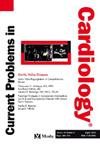Comparative analysis of electrocardiographic patterns of ventricular hypertrophy in cardiac amyloidosis and other cardiomyopathies
IF 3.3
3区 医学
Q2 CARDIAC & CARDIOVASCULAR SYSTEMS
引用次数: 0
Abstract
Introduction
The early identification of conditions that lead to increased myocardial wall thickness, such as transthyretin amyloid cardiomyopathy (ATTR-CM), severe aortic stenosis (AS), hypertrophic cardiomyopathy (HCM), and hypertensive heart disease (HHD), is challenging due to overlapping features. Delayed diagnosis can postpone appropriate treatment and worsen prognosis. This study aimed to evaluate the frequency of key electrocardiographic patterns in these conditions, with a specific emphasis on differentiating ATTR-CM from other causes of wall thickening.
Methods
Electrocardiograms (ECGs) from the medical records of 400 patients over 60 years old were analyzed, divided into four groups (ATTR-CM, HCM, HHD, and AS) with confirmed diagnoses and septal thickening (≥12 mm). Specific electrocardiographic patterns, including left ventricular hypertrophy, left atrial enlargement, low voltage, pseudoinfarction, and left ventricular pressure overload, were assessed. Multiple chi-square tests with Bonferroni adjustment were used to detect significant differences between groups.
Results
The Sokolow-Lyon criteria was absent in all ATTR-CM cases, compared to 13 % in other conditions (p = 0.001). Additionally, ATTR-CM showed a higher prevalence of low voltage (45 % vs. 18.3 %, p = 0.001) and pseudoinfarction pattern (32 % vs. 22 %, p = 0.007), but a lower prevalence of left atrial enlargement (8 % vs. 30 %, p = 0.005). Absence of the Sokolow criteria was the best predictor of ATTR-CM (sensitivity 100 %, NPV 100 %, PPV 27 %), followed by the presence of low voltage and pseudoinfarction.
Conclusions
Significant differences were observed in the prevalence of electrocardiographic patterns between ATTR-CM and other wall thickening phenotypes. These findings may aid in the early detection and diagnosis of ATTR-CM, allowing for more timely intervention.
心肌淀粉样变性与其他心肌病室性肥厚的心电图特征比较分析。
早期识别导致心肌壁厚增加的疾病,如转甲状腺素淀粉样心肌病(atr - cm),严重主动脉瓣狭窄(as),肥厚性心肌病(HCM)和高血压性心脏病(HHD),由于重叠的特征是具有挑战性的。延误诊断会延误适当的治疗,使预后恶化。本研究旨在评估这些条件下关键心电图模式的频率,特别强调区分atr - cm与其他原因的壁增厚。方法:对400例60岁以上患者的病历进行心电图分析,将其分为4组(atr - cm组、HCM组、HHD组、AS组),均确诊为房间隔增厚(≥12 mm)。具体的心电图模式,包括左室肥厚、左房增大、低电压、假性梗死和左室压力过载,被评估。采用Bonferroni校正的多重卡方检验来检测组间的显著差异。结果:所有atr - cm病例均不存在Sokolow-Lyon标准,而在其他情况下为13% (p=0.001)。此外,atr - cm显示出更高的低电压发生率(45%对18.3%,p=0.001)和假性梗死模式(32%对22%,p=0.007),但左房扩大的发生率较低(8%对30%,p=0.005)。没有Sokolow标准是atr - cm的最佳预测指标(敏感性100%,NPV 100%, PPV 27%),其次是低压和假性梗死的存在。结论:atr - cm与其他壁增厚表型在心电图模式患病率上存在显著差异。这些发现可能有助于早期发现和诊断atr - cm,允许更及时的干预。
本文章由计算机程序翻译,如有差异,请以英文原文为准。
求助全文
约1分钟内获得全文
求助全文
来源期刊

Current Problems in Cardiology
医学-心血管系统
CiteScore
4.80
自引率
2.40%
发文量
392
审稿时长
6 days
期刊介绍:
Under the editorial leadership of noted cardiologist Dr. Hector O. Ventura, Current Problems in Cardiology provides focused, comprehensive coverage of important clinical topics in cardiology. Each monthly issues, addresses a selected clinical problem or condition, including pathophysiology, invasive and noninvasive diagnosis, drug therapy, surgical management, and rehabilitation; or explores the clinical applications of a diagnostic modality or a particular category of drugs. Critical commentary from the distinguished editorial board accompanies each monograph, providing readers with additional insights. An extensive bibliography in each issue saves hours of library research.
 求助内容:
求助内容: 应助结果提醒方式:
应助结果提醒方式:


